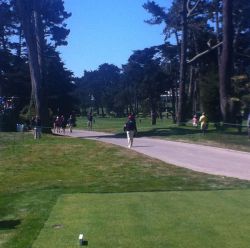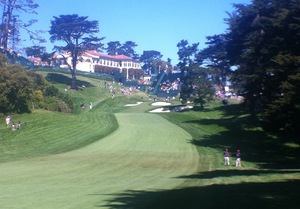When you come to think of it that is the secret of most of the great holes all over the world. They all have some kind of a twist. C.B. MACDONALD
More Videos From Olympic Club: 16, 17 and 18
/Why Don't More Courses Make Bill Burgers?
/Phil On 670-Yard 16th: "It's definitely the hardest -- arguably the worst."
/Steve Elling on Phil Mickelson's comments Tuesday about the lengthened 16th at Olympic (photo).
 And I have to agree with this design assessment, something you can see in a video shot earlier today.
And I have to agree with this design assessment, something you can see in a video shot earlier today.
“With the tee back, it eliminates any options,” he said.
So much for strategy, he added.
“I would never say it's an unfair hole,” he said. “I just don't think it's a good hole.”
Handicapping Olympic: Who The Course Favors
/When putting together pools and picks for the 112th U.S. Open I tend to look at past performances on golf courses, yet with so few in this week's field having played at Olympic Club in 1998, I would take a look at how this golf course plays. And more than most courses, Olympic seems to emphasize ball-striking to an extreme, strategic thinking less so.
 "You have to curve it more off the tees here than any other golf course that we play," Tiger Woods said Tuesday.
"You have to curve it more off the tees here than any other golf course that we play," Tiger Woods said Tuesday.
On paper, the tee shots look like a pretty even breakdown between needing to play a right-to-left shot, left-to-right shot and a dead-straight-to-not-hit-overhanging-limbs shot.
"There was no preference on either shot," Billy Casper said today of the course in '66 and today. "Because you had so many holes that had doglegs right, you had so many holes that you had doglegs left and you had so many holes where the fairway sloped from right‑to‑left and holes where you had the fairway slope from left‑to‑right. It required good stroke making to be able to play the golf course."
However, approach shots at Olympic Club tend to favor a left-to-right shot either because of green angles or the combination of fairway slope, green size and green firmness.
"Even to the greens, you've got right‑to‑left slopes of, let's say right‑to‑left slopes of fairways and greens, and you have to cut it, so you're going against the grain."
This is why I continue to feel like Tiger is an overwhelming favorite. Throw in the lack of driver holes, his preference for bent over poa greens, strong fan support in this area, a familiarity with California golf and a continuation of the predominantly left-to-right ball striking on display two weeks ago at the Memorial, and you have a deserving favorite.
And Tiger the little-known historian seems to have done his homework on this front.
"I was reading something a long time ago about Arnold playing this event," he said Tuesday. "He likes to draw the ball. But he learned how to hit a cut just for this event."
Who else works the ball left to right? Phil Mickelson, Tiger's playing partner the first two days, can certainly do so and should Lee Westwood, who once tried to change his swing to hit a draw but has wisely gone back to a fade shot shape, leaps out as someone who should thrive here.
But this is Olympic. And history tells us there's another less famous, supreme ball-striking, cut-shot artist out there who will spoil the affair. But who?
Bubba: Setup Forcing Bombing-And-Gouging
/US Open On ESPN: Duval Making His Television Debut
/"All the cart does is give him a chance. That's part of who we are as Americans."
/ Interesting perspective from Michael Bamberger on why no one seems to care these days whether Casey Martin takes a cart or not: society has changed.
Interesting perspective from Michael Bamberger on why no one seems to care these days whether Casey Martin takes a cart or not: society has changed.
There must still be plenty of people who think it's an affront to the sanctity of the game to have one player play by different rules. But many fewer than there were in the old century.
What changed? Casey Martin didn't change. He's still a golfer who can make the shots, but not the walk, that tournament golf requires. So what actually changed?
We changed.
We've become more tolerant (or so I'd like to think). The Sept. 11 attacks made us reassess the important from the trivial.
We elected a black president for the first time, and today when people are critical of Obama's performance, it has little to do with the color of his skin and more to do with the high price of gasoline.
Nobody cares if the secretary of state is a woman or a man, unless you have the view that women are more likely to keep us out of war.
Olympic With Bent Grass And Other Changes
/Dennis Miller: “Quite a journey so far"
/Rex Hoggard with an update on YouTube sensation/Sectional qualifier Dennis Miller's first practice round and media session (viewable here).
Andy Zhang: 14-Year-Old Is In The U.S. Open!
/Some Course Videos From The Olympic Club
/I Tweeted these earlier, so for those of you following me on Twitter, my apologies for the redundancy.
The rough, or lack thereof on No. 2 is fairly typical of the rest of the course. There appears to be no graduated rough and only select areas off the tee where rough is dense. It's thicker around greens.
As usual, the production values are slick.
The challenge of hitting No. 4 fairway is explained here.
The dreaded tree off five tee.
I'm not sure if you can hear it, but this is a Keegan Bradley approach into five indicating the nice firmness already in the greens.
And not for the faint of heart, the view from atop the highest 18th hole grandstand.












